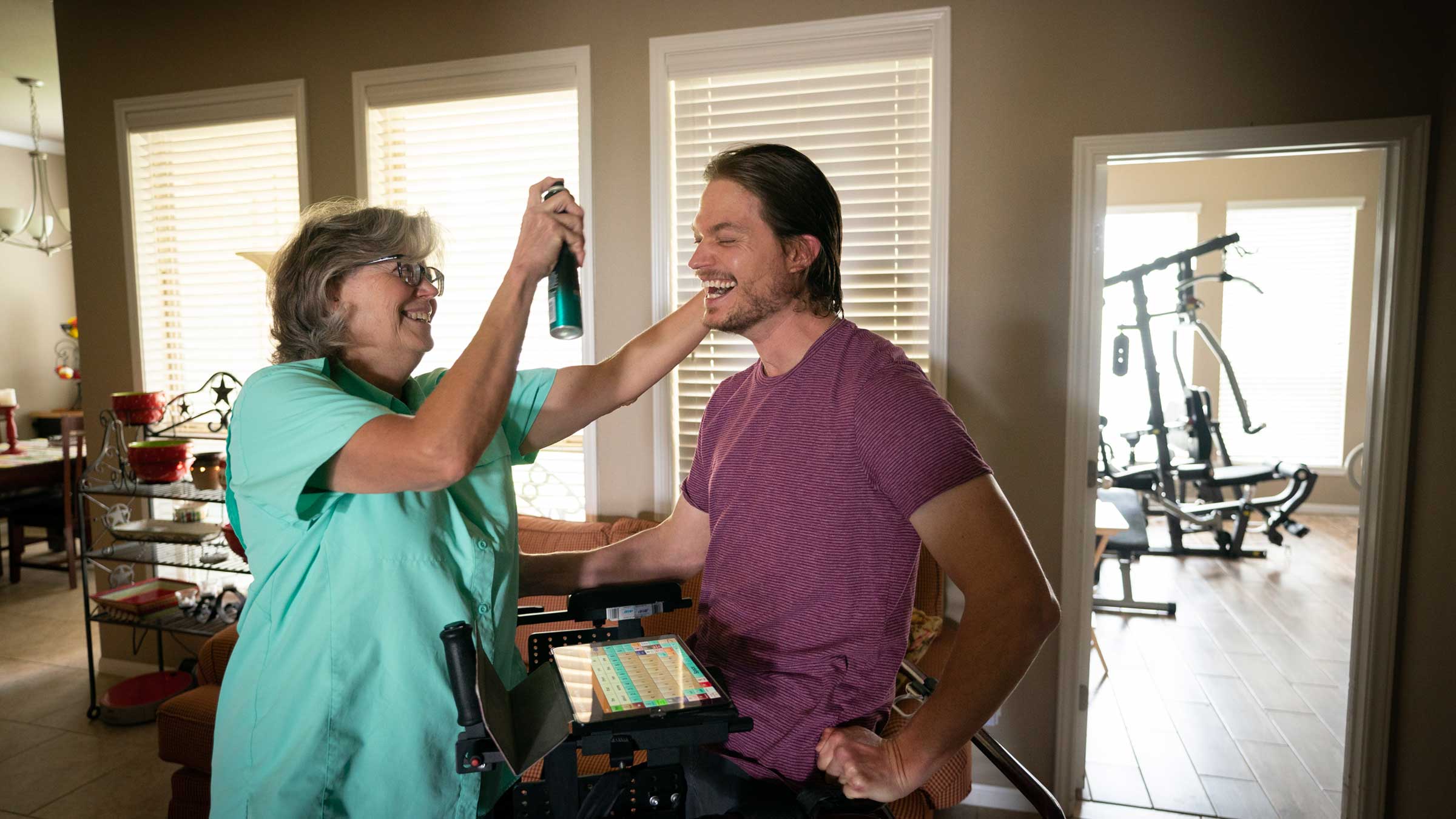
For Passenger in Drunken-Driving Crash, Healing is ‘Forever-Long Journey’
Fourteen years after barely surviving a drunken-driving crash in which he was a passenger, Sean Carter of College Station, TX, still closes his emails with the words, I will talk. I will walk again.” And if you’ve ever met Sean, you wouldn’t bet against it. He was 22 and a college junior thinking about law school on March 27, 2005, when he got into a pickup driven by a buddy—both had been drinking.
It was a rainy night, and the truck hit a tree, leaving Sean with multiple fractures, internal injuries and a diffuse axonal brain injury (DAI) … translation: extremely serious. When he came out of a coma after 39 days, Sean was unable to speak or walk.
That’s the story of what happened to Sean, but he prefers to focus on what has happened since the accident. Using an app that speaks the words he types on his iPad, he said, “The situation I put myself in sucks, without a doubt. Sometimes life just happens, and there is no way to go back in time to change what happened. All you can do is move forward.”
And he has. For the first five years after the crash, Sean needed help from his mom, Jenny, with just about everything. (Although his spinal cord is intact, Sean’s brain injury affected his mobility as well as his speech.) But in 2010, he participated in a research project at the University of Texas Medical Branch at Galveston, to measure the effects of rigorous exercise on patients with traumatic brain injuries (TBI).
Sean’s rigorous program of exercise over the past decade has continued to increase his dexterity and mobility, beyond what had been imagined with the severity of his traumatic brain injury.
There has been no short-cut to results, and Jenny remains her son’s full-time caregiver. But improvements over time have added up to amazing. Sean continues to work out, strenuously, in his home gym, at least four times a week. He now transfers himself in and out of bed, and showers and brushes his teeth independently, among many other daily-living tasks he previously had been unable to do. In 2015, he traded his wheelchair for a walker, which was a really big deal.
Sean said, “It took 10 years to get rid of my wheelchair. My walker is so big that tight spaces are still pretty impossible to move around in, but I am able to be on my feet. Improving my physical body and building muscle has been painstakingly slow, but as long as I’m progressing forward, I am able to stay pretty positive and find hope for a brighter future.”
With that bright future in mind, Sean and Jenny are living with hope and happiness in the present. “Our life is a good life,” Jenny said. “My son still can’t talk; my son has a hard time walking, but we live a really good, happy life.”
Sources of happiness and hope for Jenny and Sean include their faith—”We could not have gone through this without believing in God,” Jenny said—and being able to give back to a community that has held them close for so many years.
Giving back, which has been an important part of Jenny and Sean’s healing process, started about two years after the accident. They were asked by Mothers Against Drunk Driving (MADD) to share Sean’s story of actions and consequences with those who had been convicted of Driving Under the Influence.
Being able to once again run his hand through his hair is a hard-won gesture for Sean. He said, “Little by little, I am able to put pieces back together of my physical body, with the help of my Mom and my faith in God. They both help comfort me when I am down. I get down at times, but it’s only for a moment. I know I am still improving.”
Despite being a public speaker who can’t speak—a joke Sean tells on himself—his message of hope and healing resonates strongly with audiences. By 2010, their speaking engagements had evolved into the nonprofit WhenSeanSpeaks, Inc.
Jenny and Sean now make about about 60 presentations a year to student and community groups across Texas, through the Texas A&M AgriLife Extension Service, a statewide educational outreach program. They have also had opportunities to speak in 11 other states, through private engagements. Sharing their experience with an estimated 250,000 people over the years has helped mother and son make meaning out of tragedy.
In Sean’s CaringBridge Journal, which Jenny described as “my lifeline when I had nothing to hold onto,” she wrote, “We hope that through the expression of our emotions and thoughts about the choices that were made to get us here, we can help prevent others from sharing our consequences.”
For his part, Sean intends to keep on talking … everywhere, and with everyone. To increase visibility, he is writing a book with the help of a friend—a rough draft is in-process—about his “forever-long journey.” He said, “It would be so awesome to speak to huge audiences … to help other young people from making the same mistake I made, of getting into a vehicle driven by a drunk driver.”
Sean also thinks it would be awesome to travel to speaking engagements in a motor coach, vs. the extended-cab pickups Jenny has driven over the years. Sean said, “I am unable to help my Mom haul our luggage into hotels. A motor coach would allow us to sleep in our own beds and have everything we need.”
He smiled as his typed words turned into speech: “That’s just a dream, but everything starts with a dream.”